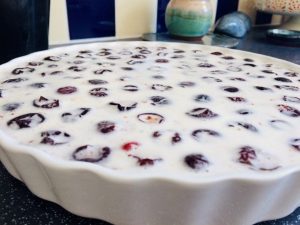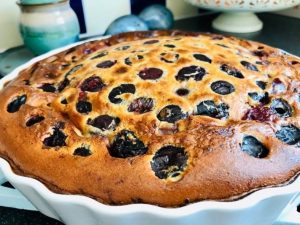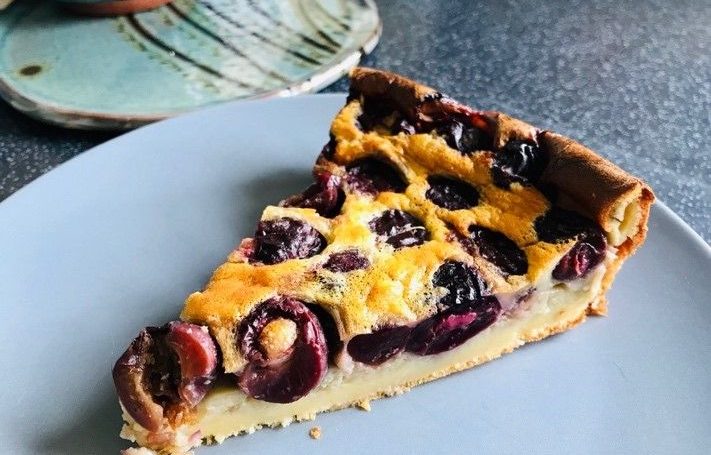This recipe is a healthier version of the traditional French treat and is a great way to incorporate different kinds of fruit. Cool and refreshing out of the fridge on a hot summer’s day or still warm in the winter, this dessert is a quickly made crowd pleaser.
The clafoutis has a ‘flan-like’ rather than a ‘cake-like’ texture, even without a rising agent. The clafoutis keeps well in the fridge for 1 – 2 days.
The quantities are based on a 25 cm – 28 cm diameter round flan dish. However, a cake tin or an ovenproof casserole dish will work just as well.
Serves: 16 slices (8 for adults)
Dietary: Nut-free
Contains: wheat, gluten (flour), eggs, milk,
Preparation time: 15
Cooking time: 20
INGREDIENTS
¾ cup (100 g) flour
4 eggs, medium size
1 cup (250 ml) milk, skimmed
300 g cherries, fresh or frozen
2 Tbsp (40 g) fruit-based syrup (instead of sugar)
1 tsp sunflower oil (to grease the flan dish)
1 tsp vanilla essence
METHOD
- Defrost the cherries and drain well.
- Preheat the oven to 200 oC/180 oC Fan/Gas Mark 6.
- Whisk eggs and syrup and then combine with the flour.
- Add a little bit of the milk and mix well.
- Step by step, add the remaining milk and stir until the mixture has a smooth and lump-free consistency.
- The mixture is fairly liquid and resembles a pancake mix.
- Now grease the flan dish/baking tin/casserole dish.
- Spread out the cherries evenly in the dish.
- Pour in the clafoutis mixture.
- Bake for 20 – 30 minutes in the middle of the oven.
- Let the clafoutis cool down in the dish, cut into slices and serve either warm or cold.
This recipe has been donated by Nicole Duernhoefer.
NUTRITION INFORMATION
Per serving (1 of 16 slices):
Total calories: 66 kcal
Fat: 1.5 g
Saturated Fat: 0.5 g
Carbohydrate: 9.8 g
Total sugar: 4.7 g
Free sugar: 2.5 g * Incomplete
Fibre: 0.8 g
Protein: 3.1 g
Salt: 0.07 g
NUTRITION FACTS
- The reformulation of this recipe does not require any butter or cream, only the oil to grease the baking dish.
- It is low in fat (with less than 3 g of fat/100 g) and low in saturated fat (0.9 g/100 g).
- It is also low in sugar.
- The chosen syrup is sweeter than refined sugar. It, therefore, reduces the amount of added sugar and calories without compromising the sweetness of the dessert and without using an artificial sweetener.
- This dessert is also a good source of protein and vitamin D.
VARIATIONS
- Add some flaked almonds to the base with the fruit to add a little more texture (no longer nut-free).
- Change the flavour by almond essence.
- A dairy-free milk alternative will make this dish suitable for a lactose-free diet.
- Use different fruit, e.g. blueberries, raspberries, apricots or mixed fruit.
- With gluten-free flour, this recipe can be used for a coeliac diet.
- To increase the fibre content, use 25% wholemeal flour.
PHOTOS



